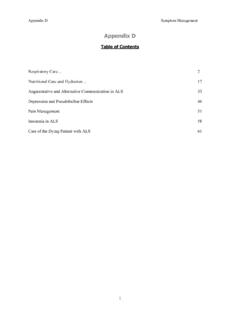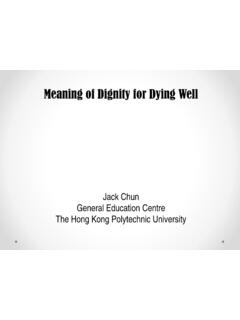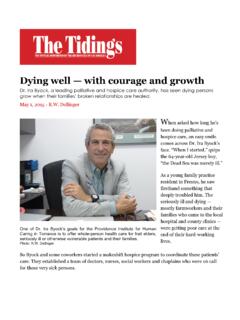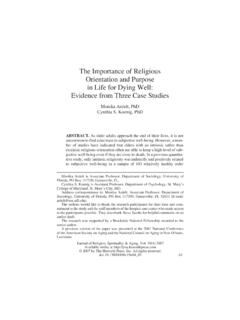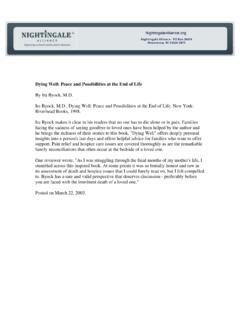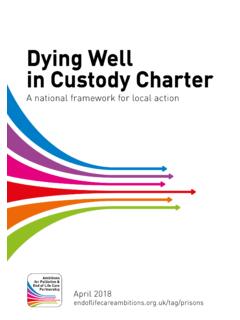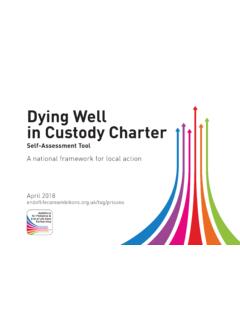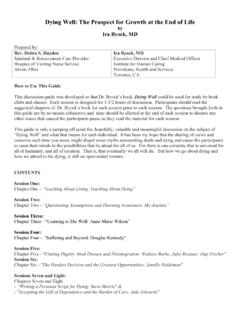Transcription of Successfully Integrating Palliative Care and Cancer Treatment
1 LivingandDyingWellwithCancer Successfully Integrating Palliative care and Cancer TreatmentPROMOTING EXCELLENCE IN END-OF-LIFE care A N A T I O N A L P R O G R A M O F THEROBERTWOODJOHNSONFOUNDATIONPROMOTING EXCELLENCEIN END-OF-LIFE CAREA N A T I O N A L P R O G R A M O F THE ROBERT WOOD JOHNSON FOUNDATION1000 East Beckwith AvenueMissoula, MT 59812406-243-6601 Phone406-243-6633 2003 Visit the comprehensive Web site of Promoting Excellence in End-of-Life care for more information on these and other innovative demonstration projects dedicated to long-term changes to improve health care for dying persons and their families: or contact:Ira Byock, , Director Jeanne Sheils Twohig, , Deputy DirectorPromoting Excellence in End-of-Life care Promoting Excellence in End-of-Life CareThe University of Montana The University of Montana1000 E.
2 Beckwith, Missoula, MT 59812 1000 E. Beckwith, Missoula, MT 59812 Phone: 406/243-6601 Phone: 406/243-6602 Email: Email: 1997, The Robert Wood Johnson Foundation launched a national program Promoting Excellence in End-of-Life care with a mission of improving care and quality of life for dying Americans and their families. We soon realized that the metaphor of a jigsaw puzzle seemed apt in describing our efforts to expand access to services and improve quality of care in a wide range of settings and with diverse populations. No single approach would suffice - a variety of strategies, models of care and stakeholders are necessary to Successfully complete the picture. This monograph represents one aspect of our work and one piece of the puzzle of ensuring that the highest quality of care , including Palliative care , is available to all seriously ill patients and their the Picture of ExcellenceAcknowledgements:About the Artists:This publication was produced by , a national program of The Robert Wood Johnson Foundation, directed by Ira Byock, Primary authors of this report are: Renie Schapiro, Ira Byock, , Director Susan Parker Jeanne Sheils Twohig, , Deputy DirectorEditorial assistance was provided by Karyn Collins, , Communications Officer.
3 We extend special appreciation to the individuals in the projects featured who gave their time to provide information for this report. The black and white photographs included in this report were taken by Bastienne Schmidt and Philippe Cheng at the Rhode Island Hospital Intensive care Unit in January 2001 as part of a project entitled "Compassionate care in the ICU: Creating a Humane Environment," funded by Ortho Biotech and Critical care /Surgery. The photographers are deeply indebted to Dr. Mitchell Levy and his staff at Rhode Island Hospital and especially to the patients and their families who allowed them into their lives during this time. The Project ENABLE photo was taken by Amy Thompson, , Lebanon, Excellence in End-of-Life CareValley NewsFor information about the financial implications of Integrating Palliative care with curative care , see the recent Promoting Excellence in End-of-Life care monograph, Financial Implications of Promoting Excellence in End-of-Life care , available at ofContents33333 Introduction77777 Ireland Cancer Center sProject Safe Conduct1111133333 University of CaliforniaDavis Simultaneous CareProject1111177777 University of Michigan sComprehensive CancerCenter Palliative CareProgram2222211111 Dartmouth s NorrisCotton Cancer Center sProject ENABLE2525252525 What Have We Learned?
4 Promoting Excellence in End-of-Life care , a national program of The Robert Wood Johnson Foundation1 There is noargument thatpalliative care ,from diagnosis todeath, should beintegrated intocancer care - NCPB Report, ImprovingPalliative care for CancerIntroductionToo many patients with Cancer suffer needlessly at the end of their life. Focus on thecure too often has diverted attention from the care that patients need. As the NationalCancer Policy Board (NCPB) of the Institute of Medicine noted in its 2001 report,Improving Palliative care for Cancer : Patients, their families and caregivers all suffer fromthe inadequate care available to patients in pain and distress. In the last several years, leaders in American medicine have put forth a new and hopefulvision for improving the comfort and quality of life for patients with advanced Cancer andtheir families. This vision recognizes that optimal care requires attention to multiple sourcesof distress that are common in illnesses such as advanced Cancer .
5 It foresees a continuum ofcancer care in which Palliative skills and services ease physical and emotional suffering andenhance the quality of Cancer patients and families lives throughout the course of Institute of Medicine has played a leading role in defining this bright vision. Its1997 report Approaching Death, and subsequent NCPB reports, including Ensuring QualityCancer care and Improving Palliative care for Cancer , document the shortcomings in carefor patients with advanced, incurable illness and identify barriers to quality care at the endof life. As the NCPB notes in Improving Palliative care for Cancer : There is no argumentthat Palliative care should be integrated into Cancer care from diagnosis to death, butsignificant barriers attitudinal, behavioral, economic, educational and legal still limit thisneeded care for a large proportion of people with Cancer . Collectively these reports call for policy changes and underscore the importance ofresearch, including demonstration projects, to help chart the American Society of Clinical Oncology has also helped point the way to this new,comprehensive standard of care .
6 In a 1998 policy statement it noted: Cancer careoptimizes quality of life throughout the course of an illness through meticulous attention tothe myriad physical, spiritual and psychosocial needs of the patient and family. Nationalhealth care philanthropies, creative, forward-thinking clinicians and researchers and cancersurvivors themselves, have all contributed to crafting a vision of this comprehensivecontinuum of care and lent their voices to a chorus calling for 1997, Promoting Excellence in End-of-Life care , a national program of The RobertWood Johnson Foundation, has worked to advance the agenda for better end-of-life carethrough an array of innovative projects. The program is based at The University of Mon-tana, Missoula under the leadership of Dr. Ira Byock. It includes an ambitious and broad-based effort to systematically build and carefully evaluate innovative models for deliveringpalliative care . Twenty-two projects from across the country were selected from a pool ofmore than 700 grant applicants to create new models that expand access to services andimprove quality of care .
7 The grantees spanned a variety of care settings, diseases and monograph reports on the results of the four Promoting Excellence in End-of-LifeCare demonstration projects that tested models of concurrent anti- Cancer Treatment andpalliative care for patients with advanced Cancer . Specifically, these models challenged theso-called terrible choice that patients living with Cancer in the United States typicallyface. Either they can pursue Cancer treatments in hope of extending their lives or they can give up and accept hospice care to relieve symptoms and to provide emotional andspiritual support for them and their families through the end of Excellence in End-of-Life care , a national program of The Robert Wood Johnson Foundation3 Hospice is currently the most developed and mostavailable form of comprehensive Palliative care , butMedicare regulations and many insurance companies policies limit hospice services to patients with a prognosisof six months or less and require patients to forego anytreatments aimed at extending life.
8 In practical terms,patients must either refuse any further Cancer treatmentor exhaust all available treatments to receive hospiceservices. This sequential arrangement all availabledisease-modifying Treatment and then referral to hospicefor Palliative care denies needed services to manypatients and families at the most difficult time in arbitrary forced choice between disease-modifying Treatment and care focused on comfort andquality of life ignores the real needs and legitimatedesires of patients with progressive Cancer , their familiesand often their physicians. It defies the reality thatpatients often want to pursue even long-shot efforts tostem the course of the disease, including entering clinicaltrials of experimental therapies, while also receiving caredirected at their comfort and support for their , the price patients pay for continuing to fight isloss of access to comprehensive care for their and theirfamilies physical, emotional and spiritual needs.
9 Manywho do receive hospice services are typically served forabout two weeks before death, too late for patients andfamilies to fully in Cancer research and Treatment havetransformed Cancer from a disease that typically leads todeath soon after diagnosis, as it was for most of thetwentieth century, to a chronic disease that manypatients live with for years. Still, at present, at least halfof all people diagnosed with Cancer will eventually diefrom the disease. The National Cancer Institute (NCI),which leads the nation s thirty-plus-year-old war oncancer, continues to focus solely on victory. It devotesless than 1% of its annual budget of about $4 billion toany aspect of symptom control, Palliative care or end-of-life research, according to the NCPB report ImprovingPalliative care for Cancer . As that report noted, Inaccepting a single-minded focus on research toward cure,we have inadvertently devalued the critical need to carefor and support patients with advanced disease.
10 Surveys show that psychosocial issues are primaryconcerns among patients with life-limiting diseases suchas Cancer . Patients who are treated at one of our nation s39 NCI-designated Comprehensive Cancer Centersunderstandably assume that they will receive top-of-the-line care . Yet NCI awards the vaulted ComprehensiveCancer Center designation solely on an institution sresearch prowess, and not on the basis of quality of a result, patients who are dying from Cancer , particu-larly those suffering from pain, fatigue, breathlessness oremotional distress, may find themselves and theirfamilies to be refugees in the war against Cancer , feelingforgotten, abandoned and Projects: ApplyingTheory to Health Service Deliveryand PracticeThe Institute of Medicine, its National Cancer PolicyBoard, The American Society of Clinical Oncology and ahost of other leading voices in Cancer care have called usto a new, higher vision that eliminates the terriblechoice.
